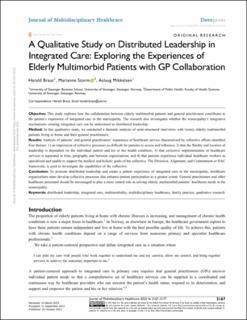| dc.contributor.author | Braut, Harald | |
| dc.contributor.author | Storm, Marianne | |
| dc.contributor.author | Mikkelsen, Aslaug | |
| dc.date.accessioned | 2023-11-28T08:59:10Z | |
| dc.date.available | 2023-11-28T08:59:10Z | |
| dc.date.created | 2023-10-29T12:49:32Z | |
| dc.date.issued | 2023 | |
| dc.identifier.citation | Braut, H., Storm, M., & Mikkelsen, A. (2023). A Qualitative Study on Distributed Leadership in Integrated Care: Exploring the Experiences of Elderly Multimorbid Patients with GP Collaboration. Journal of Multidisciplinary Healthcare, 3167-3177. | en_US |
| dc.identifier.issn | 1178-2390 | |
| dc.identifier.uri | https://hdl.handle.net/11250/3104920 | |
| dc.description.abstract | Objective: This study explores how the collaboration between elderly multimorbid patients and general practitioners contributes to the patient’s experience of integrated care in the municipality. The research also investigates whether the municipality’s integrative mechanisms creating integrated care can be understood as distributed leadership.
Method: In this qualitative study, we conducted a thematic analysis of semi-structured interviews with twenty elderly multimorbid patients living at home and their general practitioners.
Results: Analysis of patients’ and general practitioners’ experience of healthcare service characterized by collective efforts identified four themes: 1) an impression of collective processes as difficult for patients to access and influence; 2) that the fluidity and location of leadership is dependent on the individual patient and his or her health condition; 3) that collective implementation of healthcare services is separated in time, geography and between organizations; and 4) that patients experience individual healthcare workers as specialized and unable to support the medical and holistic goals of the collective. The Direction, Alignment, and Commitment or DAC framework, is used to investigate the capabilities of the collective.
Conclusion: To promote distributed leadership and create a patient experience of integrated care in the municipality, healthcare organizations must develop collective processes that enhance patient participation to a greater extent. General practitioners and other healthcare personnel should be encouraged to play a more central role in solving elderly multimorbid patients’ healthcare needs in the municipality. | en_US |
| dc.language.iso | eng | en_US |
| dc.publisher | Dovepress | en_US |
| dc.rights | Navngivelse 4.0 Internasjonal | * |
| dc.rights.uri | http://creativecommons.org/licenses/by/4.0/deed.no | * |
| dc.title | A Qualitative Study on Distributed Leadership in Integrated Care: Exploring the Experiences of Elderly Multimorbid Patients with GP Collaboration | en_US |
| dc.type | Peer reviewed | en_US |
| dc.type | Journal article | en_US |
| dc.description.version | publishedVersion | en_US |
| dc.rights.holder | © The Author(s) 2023 | en_US |
| dc.subject.nsi | VDP::Medisinske Fag: 700 | en_US |
| dc.source.journal | Journal of Multidisciplinary Healthcare | en_US |
| dc.identifier.doi | 10.2147/JMDH.S412283 | |
| dc.identifier.cristin | 2189618 | |
| dc.relation.project | Universitetet i Stavanger: IN-11551 | en_US |
| cristin.ispublished | true | |
| cristin.fulltext | original | |
| cristin.qualitycode | 1 | |

